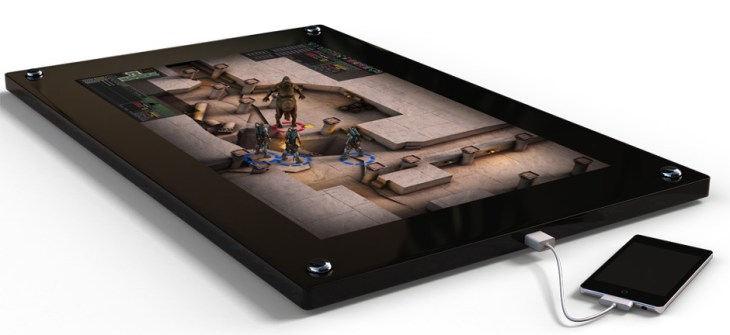At the risk of sounding a little old-fashioned, ePawn CEO Christophe Duteil thinks that there’s something missing with the way people play games these days. Modern gaming lacks “conviviality” — the sensation of revelling with good company.
His vision of gaming aims to bring people into the same physical space once again, an experience that has become less relevant thanks to fat data pipes and networked consoles. To that end, Duteil and his team at ePawn are slaving away on the ePawn Arena: a Microsoft Surface-esque screen that aims to bring gamers back into the same room by adding a modern twist to an classic idea.
In essence, the ePawn Arena is a big screen that is capable of interacting with the physical pieces that sit on top of it. Up for a rousing game of air hockey? Break out the ePawn-compatible paddles and have at it. Or how about a little fantasy-RPG action? There are parts for those too. Curiously, the screen itself doesn’t have computing components in it — rather, it relies on the horsepower from the smartphone (or computer) you connect it to.
According to CTO Valentin Lefevre, the Arena employs a sub-LCD tracking layer that is capable of detecting the ePawn tags attached to their game pieces. ePawn is planning on reaching out to big-name game development studios like Ubisoft, but doesn’t want to leave the little guys out too: iOS and Android SDKs are in the works, so developers of all stripes will soon to able to make ePawn-friendly apps.
If the concept sounds a little familiar, that’s because they’re not the first to explore the nexus between physical parts and software. Microsoft’s Surface is a prominent example, but Disney Mobile has recently released AppMates, a multimedia play experience that allows players to explore some of Disney’s worlds by manipulating a physical piece on top of the screen. I referred to it as an “interactive playmat,” but with the screen measuring only 10 inches diagonal, calling it a “mat” may have been a bit of a stretch.
Duteil certainly agrees with me here — according to him, that sort of setup isn’t ideal for the avid gamer. It’s too small, too constraining for multiple people to enjoy.
That’s why ePawn has decided to go big with the display — the way they see it, bigger displays mean room for more people. The current prototype kicking around ePawn’s Paris headquarters comes in at 23 inches across (which made a splash at this year’s E3), but Duteil tells me that the production model is even bigger at 26 inches. What’s even more impressive is the price point they’re aiming to launch at: $400. The company hopes to pick up more steam at CES 2012, and aims to launch soon afterward.
While chatting with Duteil and Lefevre, they kept repeating the same phrase over and over: the ePawn system is “designed by gamers, for gamers.” While it easily has potential as a nascent marketing mantra, these guys really seemed to mean it. For them, ePawn is a labor of love — it may well stay just that too, because the jury is still out on whether or not a market for something like this exists.
While much cheaper than a device like Microsoft and Samsung’s new Surface display table, $400 is a non-trivial amount for most gamers, and I’d imagine that most of them would rather spend it on something a little less flash-in-the-pan. ePawn’s own website describes the the Arena as an “investment,” and Duteil tells me that while the Arena could certainly find use in the business sector (think “digital whiteboards” for collaborative training), it’s primarily targetted at tech-savvy families.
So, in TechCrunch parlance, will it fly or die? As a hardcore board game nerd, there’s something strangely appealing about the marriage of old and new as seen in the Arena. There’s definitely potential for the Arena to go far, but it’s very early in the game for ePawn: they’ll need developers to make compatible games, and enough buyers to make the whole endeavor worthwhile. Still, if Duteil and his team play things right, it could be a big win for both them and fans of playing games in person.
